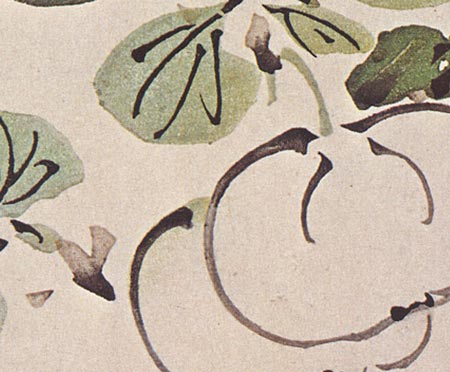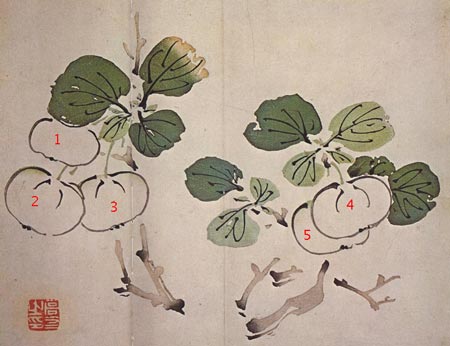Posted by Dave Bull at 2:44 AM, September 16, 2011 [Permalink]
Now that everybody has had time to think about possible solutions to the Chinese print mystery outlined in yesterday's post, let's see what we can discover ...
First, some response to a couple of the comments left yesterday:
the seal smudged from washing ...
The seal was almost certainly applied later - being pressed from the front - and wasn't printed. The pigment used for seals commonly contains oil-based components (to stop the stamp pad from drying out), and this kind of faint bleeding is very common on old work. I doubt that this one has been washed ...
one leaf of a 'step-by-step' painting manual ...
Such manuals did (and do) exist, but the Ten Bamboo Studio is not one of them. The images are all provided in 'complete' form, and are intended as models for students to copy and learn from.
light green underlayment ...
This is where my suspicions were first directed. A green tinge at the top edge of this sort of fruit could be quite realistic, and I originally thought this might be what we are seeing.
But there is a much more likely explanation.
Here's a closeup of the slight green tinge on one of the two fruits at the right side of the image:

Where else in this image do you see that same shade of green? Yes ... right directly above the questionable place, on the light green leaves. This is a no-brainer! That fruit was carved on the same block as the paler leaves, and the printer was a tiny bit careless, and let his brush touch the unwanted place.
Let's number these to explain:

Fruits #3 and #5 are on the same block at the light green leaves. Fruit #2 is together with the dark green leaves. In each case, the printer has 'bumped' them slightly. Fruits #1 and #4 will be on a block of their own. Lest you think that this sort of carving - with multiple colour zones on a single block - is rather unlikely, I can tell you from long personal experience (with both my own work, and seeing many other blocks) that it is very common indeed. You want to get as much stuff on any given block as you can.
The first edition of this book - so we are told - was a high-quality very carefully made edition. So there we are - after seeing what he had done, the printer pulled this sheet out of the stack and tossed it aside. It never got completed ... why waste the time?
i can't believe it took me so long to see this. After all, this is a clear case of ... 'been there, done that!'

